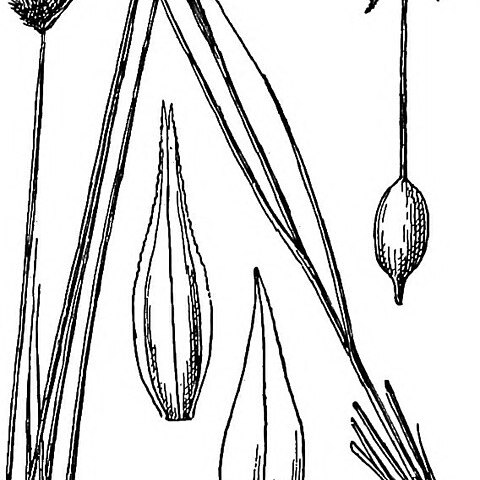Plants densely cespitose. Culms 25–60(–85) cm; vegetative culms with few leaves clustered at apex. Leaves: sheaths adaxially white-hyaline, summits U-shaped; distal ligules 1.5–6 mm; blades (2–)3–4(–5) per fertile culm, 7–22 cm × 2–4 mm. Inflorescences erect, usually dense, green, gold, or dark brown, 1.8–3 cm8–14 mm; proximal internode 2–3(–5) mm; 2d internode 1–3 mm; proximal bracts bristlelike, shorter than or equaling inflorescences. Spikes 6–14, distant, distinct, ovoid to broadly ovoid, 8–10 × 4.5–6.5 mm, base and apex acute to truncate. Pistillate scales gold to dark brown, with whitish, green, or brown midstripe, lanceolate, 3–3.8 mm, shorter and narrower than perigynia, apex acuminate to short-awned. Perigynia ascending, white to gold or light brown, 0–5-veined abaxially, 0–4-veined adaxially, narrowly lanceolate to narrowly ovate, flat except over achene or, occasionally, plano-convex, 3.4–4.1(–4.7) × 0.9–1.3 mm, 0.15–0.35 mm thick, margin flat, including wing 0.1–0.2 mm wide, usually crinkled distally; beak brown or red-brown at tip, flat, ± ciliate-serrulate, abaxial suture inconspicuous, distance from beak tip to achene (1.8–)2.1–3 mm. Achenes ± elliptic, 1.1–1.5 × 0.6–0.8 mm, 0.15–0.35 mm thick; style usually persistent, sinuate. 2n = 52, ca. 66, 70.
More
Tufted, 2–7 dm, aphyllopodic; main lvs 1–3 mm wide, shorter than the stems; sheaths ventrally hyaline; spikes 5–12, gynaecandrous, 5–10 mm, subglobose to oblong, pale greenish to dull-stramineous or tan, sessile in a compact spike or narrow head 1.5–3 cm; bracts inconspicuous, or the lowest one to about as long as the infl; pistillate scales shorter and narrower than the perigynia, sometimes mucronulate; perigynia appressed-ascending, planoconvex and not much wider than the achene, 3.3–4 × 0.8–1 mm, 3.5–5 times as long as wide, lightly few-nerved on both sides or nearly nerveless especially ventrally, narrowly wing-margined and serrulate, especially distally, tapering gradually into the slender, distally terete beak; achene lenticular, 1–1.3 × 0.6–0.7 mm; 2n=68, 70. Wet soil, meadows, swamps, and shores; Nf. to B.C., s. to N.J., Mich., Minn., and Wash.

